
|
||
Total Hardness Data for 2000 - Boulder Creek at Dry Creek |
||
Preliminary Data - subject to revision | ||
Hardness generally refers to the amount of calcium and magnesium in water. In household use, these cations (ions with a charge greater than +1) can prevent soap from sudsing and leave behind a white scum in bathtubs. In the aquatic environment, calcium and magnesium help keep fish from absorbing metals, such as lead, arsenic, and cadmium, into their bloodstream through their gills. Therefore, the harder the water, the less easy it is for toxic metals to absorb onto gills. Water in the Boulder Creek watershed is generally soft because the water comes mainly from melting snow which is low in minerals and metals.
| Data Source: | |
| Point of Contact: | |
|
| ||

|
||
| ||
| Date | Hard mg/L as CaCO3 |
|---|---|
| June, 2000 | 90.0 |
| October, 2000 | 200.0 |
| *value below detection limit: | |
| Detection Limit (if available) | 0.1 |
Preliminary Data - subject to revision
Return to the BASIN water quality catalog
Return to the BASIN environmental data catalog
About BASIN | Attribution | Feedback | Search